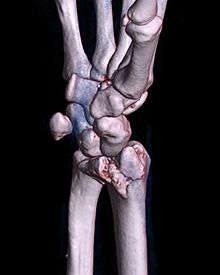Barton's fracture
| Barton's fracture | |
|---|---|
 | |
| A palmar Barton's fracture of the right wrist, as shown on a 3D-rendered CT scan | |
| Specialty | Orthopedic |
A Barton's fracture is an intra-articular fracture of the distal radius with dislocation of the radiocarpal joint.
There exist two types of Barton's fracture – dorsal[1] and palmar, the latter being more common. The Barton's fracture is caused by a fall on an extended and pronated wrist increasing carpal compression force on the dorsal rim. Intra-articular component distinguishes this fracture from a Smith's or a Colles' fracture. Treatment of this fracture is usually done by open reduction and internal fixation with a plate and screws, but occasionally the fracture can be treated conservatively.
Eponym
It is named after John Rhea Barton (1794–1871), an American surgeon who first described this in 1838.[2][3]
Additional images

References
- ^ Dorsal Barton's Fracture / Dorsal Shearing Frx – Wheeless' Textbook of Orthopaedics
- ^ synd/2821 at Who Named It?
- ^ J. R. Barton. Views and treatment of an important injury of the wrist. Medical Examiner, Philadelphia, 1838, 1: 365–368.
External links
